Dominiques, America’s oldest chicken breed, known as the Pilgrim Fowl, are a heritage breed of chicken that was popular in Colonial times.
The Dominique is an old breed that has been in North America since colonial times. The breed’s origins are unknown, but many believe that the chickens were brought over from Europe during the early 1600s. It became one of the most popular breeds in New England. It was often referred to as “the Pilgrim’s chicken” or “the American gamefowl.”
This bird is an American icon and has been around since 1750 as a dual-purpose chicken. They are cold hardy brown egg layers, and their possible Haitian roots may be where we can attribute their ability to withstand hot weather.
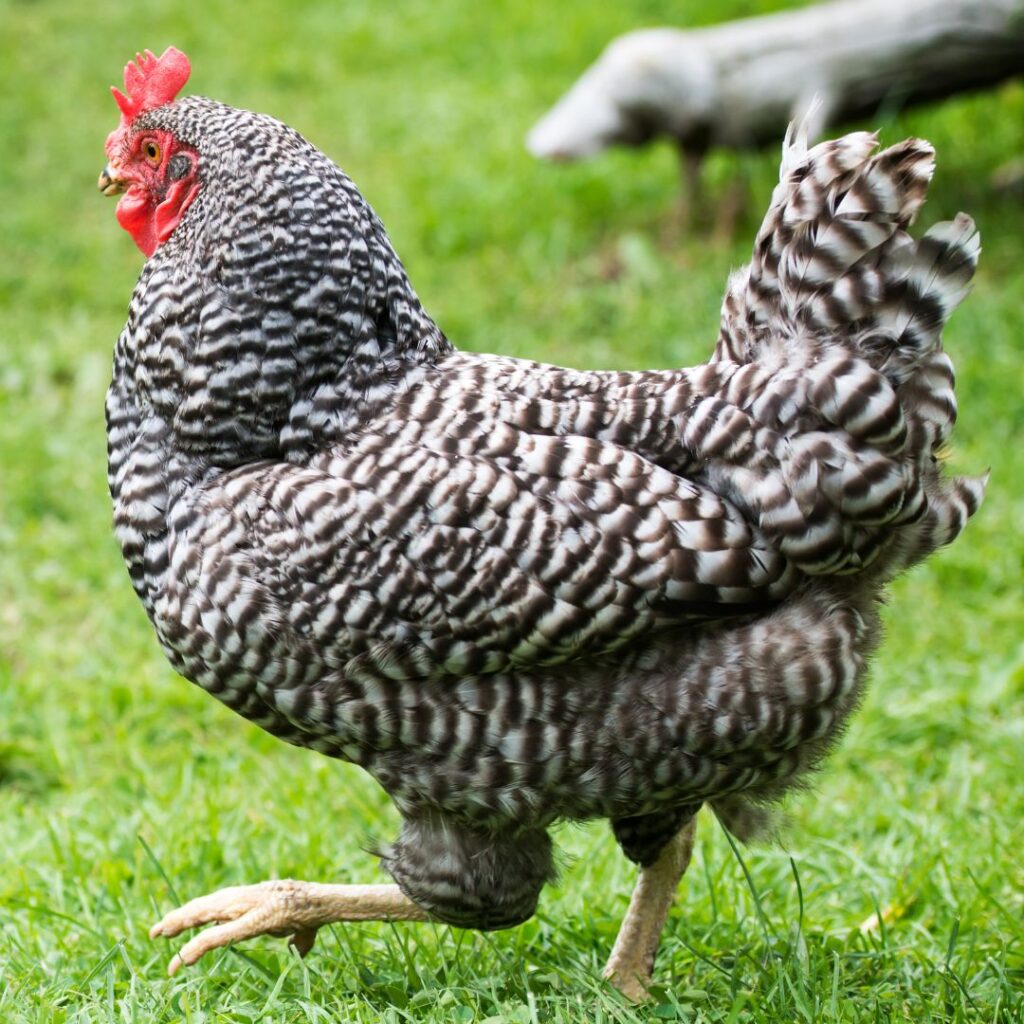
History Of America’s Oldest Heritage Chickens
The Dominique chicken origin is steeped in history, having been recognized as America’s oldest breed of domestic chicken. Exactly where it originated, however, remains shrouded in mystery. Some maintain that these fowl were brought over from Southern England by the Pilgrims, hence their original name, “Pilgrim Fowl.” Also referred to as The Puritan Fowl and Plymouth County Fowl.
Yet others suggest origins closer to home, posting that the chickens may have migrated as a Dominican chicken breed with the French colonists, from the French colony of Saint Dominique, to what is now known as Haiti and took on the name “Dominic” or “Dominiker” as a result.
Through its storied evolution, the breed has also gone by many other names, such as Dominica, Dominico, Dominicker, Dominecker, Blue Spotted Hen, and Old Grey Hen.
The origins of this old-timey bird may remain unknown, but one thing is for sure; this hardy breed continues to capture our hearts and minds today.
Fun Fact: Aside from the appeal of chickens for their eggs and meat, these and other chickens were used to stuff pillows.
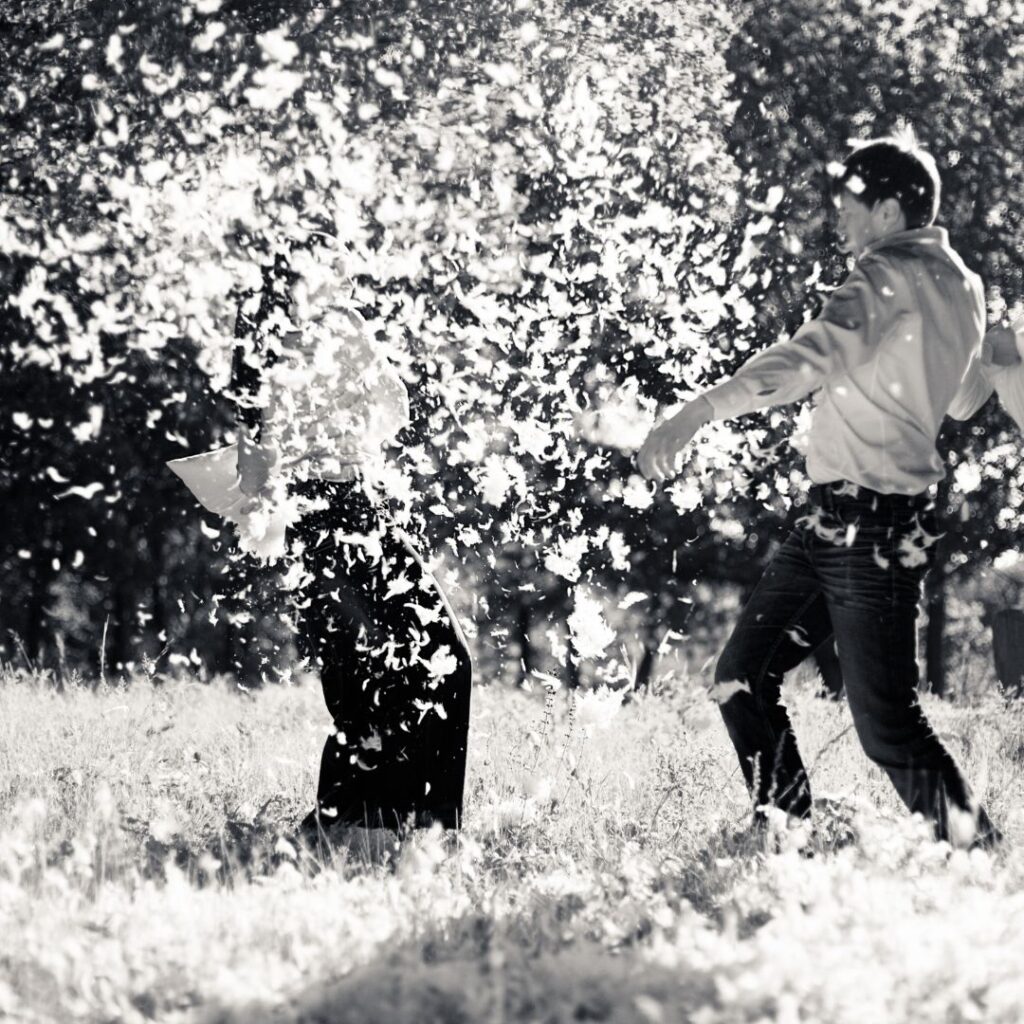
Saving An American Chicken Icon
Historically known as Pilgrim Fowls, the Dominique Chicken breed was once popular throughout New England and the American Midwest. However, its popularity dwindled in the 1920s when long-time enthusiasts and breeders passed away.
The hardy and low-maintenance nature of the bird meant that it survived during the Great Depression but was ultimately unable to compete with industrial, commercial poultry operations after World War II.
By 1970, only four flocks were left in the United States: Henry Miller, Edward Uber, Robert Henderson, and Carl Gallaher.
Fortunately for this iconic breed, with the collective efforts of these individuals and The American Livestock Breeds Conservancy (now known as the American Livestock Conservancy) “commenced a “breed rescue” mission to ensure this breed survived and to help save the Dominique bloodlines from extinction. Lucky for us, this proactive effort has helped to ensure that today we can appreciate these often overlooked birds.
What Do Dominique Chicken Breeds Look Like?
After much debate, In 1871, The New York Poultry Society determined that only the rose-combed poultry would be included in the standard of the Dominique breed.
Dominique’s barred black (dark grey) and white (creamy colored) plumage is also called the “Cuckoo Pattern.” The feathering is arranged close together (tightly).
This particular breed of rooster has a unique “u” shaped back. They are also broad and full-bodied with long and full tail feathers that sit higher than most American breeds.
Mature hens have sloped backlines that extend from their heads to their tails.
Mature hens weigh approximately 5 pounds, while roosters weigh an average of 7 pounds.
A rose comb featuring a short upward (tapered) point at the end is permitted per the breed standard. The Dominique chicken has red combs, wattles, and earlobes. Legs are yellow, short, and stout, with four toes and without feathers. Skin is also yellow.
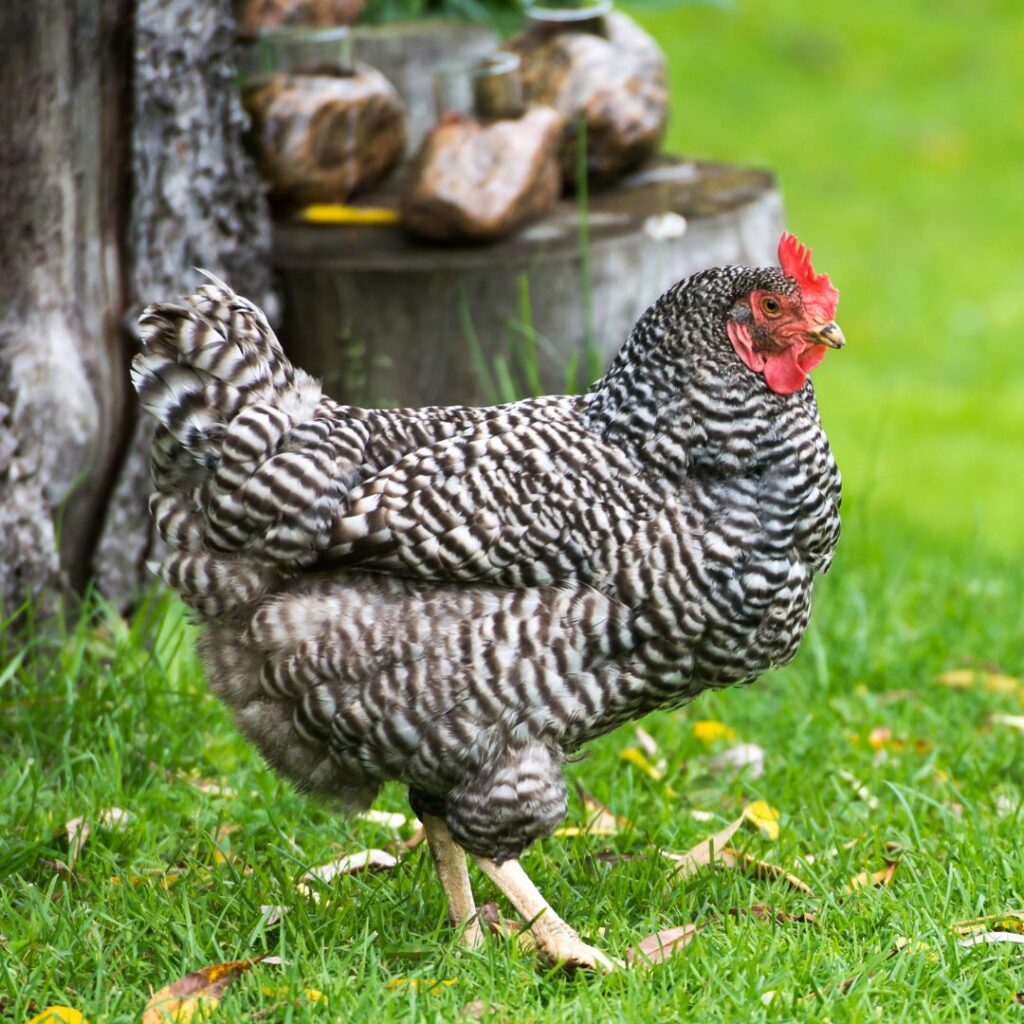
What Is A True Rose Comb?
The Rose comb is fleshy, solid, and has a low profile and broad, almost flat on top. This comb type ends in a tapered spike.
This comb type is desirable in chicken breeds raised in cold weather. Their shorter combs are more resistant to frostbite.
What Do Baby Dominique Chicks Look Like?
The gender of baby Dominique chicks is recognized by the white (sometimes creamy-colored) spots on their heads.
This is against the soft downy plumage that is dark grey and black (charcoal). The baby chicks also have that same creamy white on their bottoms (tail feathers), and if you look closely, you’ll notice some of that creamy whitish color on their wing tips.
The spots on the females, while small, are more concentrated and show only on the top of their heads. Also, female chicks can be distinguished by their rusty orange-brown legs.
Males tend to have more diffused spots that are scattered. Additionally, male Dominque chicks have bright yellow-orange legs.
Dominique Hens; Egg Production
When Do Dominique Chickens Start and Stop Laying Eggs?
Dominique hens will start laying around 20 weeks old. The hens will reach peak egg production around 2-3 years, and each year following egg laying will slow down by about 10%. Find out more about why chickens stop laying eggs in this article.
What size and egg color Is The Dominique Chicken Egg?
Eggs from your Dominique hen will be medium-large and size and brown.
When hens start laying, you’ll notice eggs are smaller, but as time goes on, the eggs will increase in size.
How many eggs do Dominique Hens Lay?
On average, your Dominique ladies will lay four eggs a week and a total of approximately 175-250 eggs a year.
See tips on how to clean and store eggs here.

Are Dominique hens Good Mothers?
These Pilgrim ladies go broody and set on their eggs to hatch their baby chicks. Dominickers are nurturing and good mothers.
Read more about broody hens here.
Is the Dominique Chicken A Dual Purpose Breed?
You can provide a good meal from this dual-purpose breed, with the roosters and the dual-purpose hen.
Are the Dominique Chickens Friendly Birds?
The Dominique chicken is a friendly and docile bird, perfect for any backyard flock or hobby farm. They are gentle and non-aggressive and make a good choice for first-time chicken keepers.
You can walk amongst your flock of Dominiques without them getting all flustered – they stay mostly calm under the care and attention of their keeper.
These chickens are pretty content with being picked up and handled, making them an ideal pet for families with young children.
This breed would do best with other docile and friendly chicken breeds like the Orpington, Cochin, Brahma, and Welsummer.
Are Dominique Roosters Aggressive?
Dominique roosters are generally gentle and easy to work with, making them great for small and large farms. They won’t attack unless threatened or provoked. Some roosters may be more assertive around mating season.
Roosters are natural protectors of their hens, so they must stay alert and act confidently when necessary.
Are Dominique Chickens Noisy?
Dominique chickens have a reputation for being quite chatty. Although the volume of their cackles isn’t always terribly high, it has been known to be a nuisance to those living nearby.
A Dominique Rooster can be even louder as they are known for their love of crowing, which can last all day long. However, like any chicken breed, some birds may be more talkative than others, so their noise levels may vary.
Are Dominique Chickens Bantams?
(Sometimes affectionately referred to as Doms and “the Dom”)
Dominique chickens are standard-sized chicken breeds. However, there is a bantam version of the Dominique.
American Bantam Association (or ABA) recognizes the Dominique Bantam as a miniaturized breed of the standard Dominique chicken. The American Poultry Association also recognizes the bantam. They are said to have been initially developed in Germany.
The Dominique Bantam chicken looks like its larger counterpart with its black and white barred plumage.
These chickens, when mature, weigh about 24 oz for hens and 28 oz for roosters. They are colored up just like the Standard Size with their rose comb, and in their younger form, they are known as Pullets (22 oz) and Cockerels (26 oz).
This breed of chicken enjoys being around people and has a calm demeanor that makes it perfect as a family pet.
Additionally, they are excellent layers of small brown eggs, making them a great choice if you want to be self-sufficient in egg production.
Being known to be broody hens, children can also experience the educational opportunity of watching how these beautiful creatures take care of their eggs.
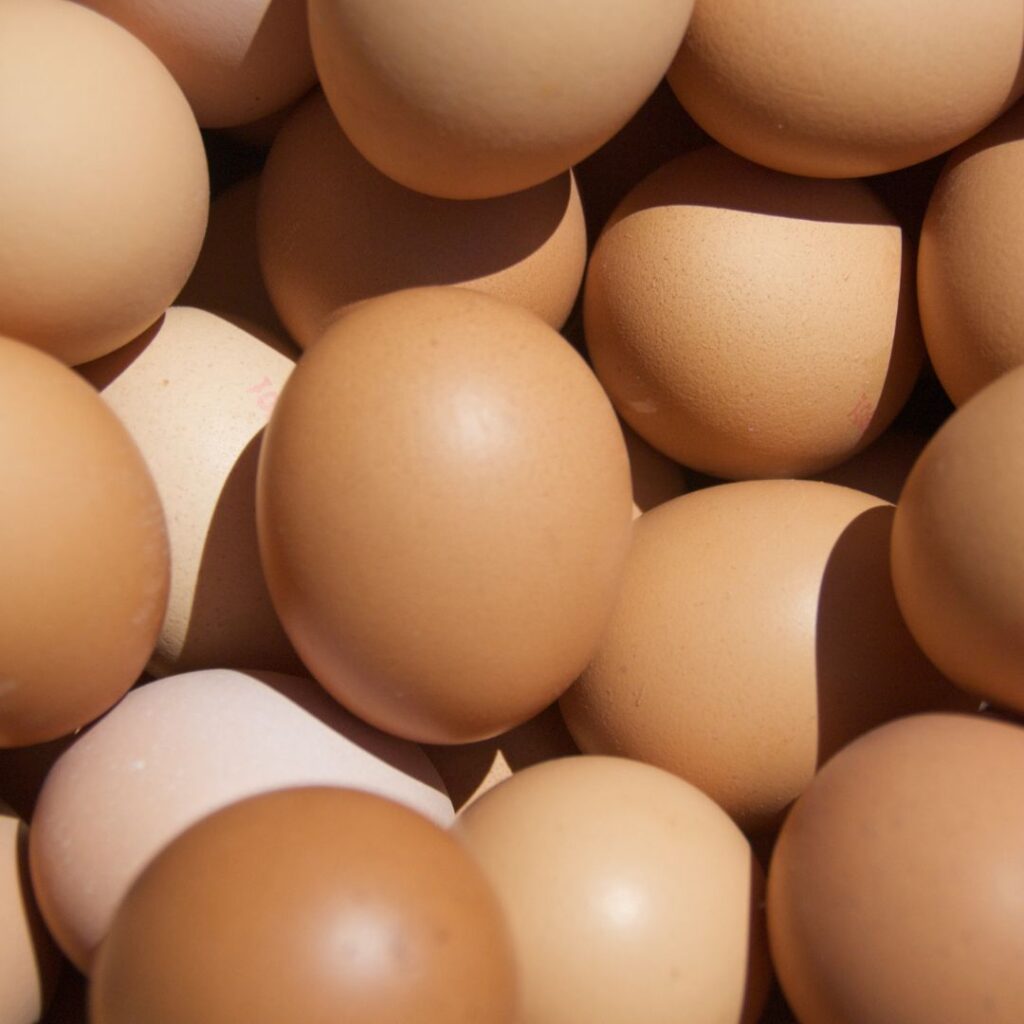
The Chicken Coop (aka the Hen House)
The space inside your hen house will provide for your flock to move about comfortably, a safe shelter, and a place to call home. You’ll need enough room for feeders, waterers, nesting boxes, and roosts for resting. All these things will equal a healthier, happier chicken.
Space – When thinking about a home for your Dominque chickens, consider a coop that is big enough for them to move around and be comfortable. Providing them with at least 6-8 square feet per bird is vital to their well-being.
Building your chicken coop is an option and if you choose to do so, make sure to use weatherproof materials so they can stay warm in winter and cool in the summer. Always ensure your coop is well-ventilated – this is essential for your chickens’ health.
If constructing a coop isn’t an option, plenty of pre-made coops still provide a good living space. Whichever you choose, providing the right environment for your Dominique flock will ensure they are healthy and happy.
Roost – When setting up a chicken coop, one of the most important things to determine is where the roosts will be placed. It’s best to keep them toward the back, away from windows and doors, so that drafts don’t cause harm to your chickens and they stay out of their nesting boxes at night.
Please ensure they are level and secured to the coop’s walls. To find out how many roosts you need, count your flock and multiply it by 1 foot – each chicken needs at least 1 foot on the roost for comfort. Aim for 2-4 feet off the ground since any higher than that increases their chances of injury.
Nesting boxes – Having the correct-sized nesting boxes for your chickens is essential for their comfort and egg-laying. For the most common breeds like Leghorn, Sussex, Plymouth Rocks, and hybrid layers, a good rule of thumb is one box per four females with a 12-inch cube.
By having enough space in each box, your chickens won’t look elsewhere to lay their eggs since they’re comfortable inside.
Remember to change the bedding regularly, which reduces egg breakage and keeps it fresh.
It’s important to consider if you have a Dominique hen hatching eggs or raising chicks, as they’ll need extra space in the nesting box and proximity during the hatching season.
Feeders and Waterers – Place feeders and waterers so above ground but not so high that your chicken can’t comfortably eat and drink. The placement will save your waterers from filling up with litter and feeders from getting dirty or even ants crawling in easily. Keep food and water fresh, clean, and filled at all times.

The Chicken Run For Your Dominique Chicken Flock
Space – Whether you’re raising chickens for their egg production or as pets, it’s essential to provide them with ample outdoor space. Chickens are very social and spend much of their time outdoors, pecking and scratching in search of food.
Considering how much space to provide depends on the breed’s size and whether you plan to give your chickens access to forage throughout the day. For example, suppose you have larger breeds like Dominiques, Barred Rocks, or Buff Orpingtons. In that case, it’s recommended that each chicken has 10 square feet of outdoor living space.
But remember: just because they can have only 10 sqft doesn’t mean they should — the more space they have access to, the happier they’ll be. By providing your chickens with plenty of room to roam around and explore, you can be sure that both your birds will be contented and that your investment pays off in tasty eggs!
Fencing height – Chicken wire can be great for fencing your chicken enclosure when constructing a chicken run. Secure fencing helps keep your chickens safe and prevents them from getting away. Height is also critical. The fence needs to be tall enough that no predators can jump over and snatch a chicken, so six feet is the recommended height for chicken runs.
Keeping hardware cloth or chicken wire secure over the top of your run will ensure the area stays predator-proof. Fencing height will go a long way toward keeping your chickens safe and secure in their own enclosed space.
Perches – Perches are a great way to add space and exciting ways for your flock to explore. They are also places your chicken can escape if there’s a dispute in the run area. Think about saving that old fallen branch and securely leaning it up against a fence or secure post. Consider nailing a few 12″ deep boards to the side of the coop; even a chicken’ swing’ or an overturned box or bucket will give your chickens places to hop up on and explore.
Dust Bath – A dust bath should be a must-have for chicken owners since it provides many benefits! Dust baths eliminate parasites and mites, allowing chickens to stay healthy and protected. These dry baths also keep feathers clean and in good condition, even during the cold winter. This simple activity can benefit your flock as long as the dust bath material is non-toxic.

Hot and Cold Weather Tips For The Chicken Coop (Hen House)
A chicken coop must be draft-free and have insulation so the chickens can withstand colder weather. Adequate ventilation is key to preventing moisture from gathering, which could lead to severe problems. Don’t forget that food and water are necessities year-round! Chickens need to be able to access food and water constantly, but this is especially important in cold weather when they expend more energy. Ensure your chickens have a roost where they’ll be safe from cold floors and drafts.
Waterers and Feeders –Some chicken keepers find winter more challenging to manage. To provide your flock with fresh water, you must frequently replace their water source. This can be incredibly challenging if you are busy or away from home for extended periods. However, some heated waterers and bowl warmers available on the market may help make things easier. Although they come with a higher price tag, they could be worth the investment for many people.
Frostbite – Dominiques are less likely to get frostbite because of their rose comb. However, it is worth it to be prepared. Frostbite is a considerable threat to chickens with large combs, especially roosters. Not only is frostbite painful, but it can also cause long-term problems for your flock. The good news is that most hobby farmers and chicken keepers have more hens than roosters. Many people in the chicken community use petroleum jelly to safeguard their flocks.
Run Prep – shovel your chicken coop to give the birds space to move around and get some exercise during the day. Prepare for bad weather by having a section of the run covered so they can take shelter from rain or snow. Chickens don’t mind if there is snow on the ground, but if it falls on their feathers, it will make them wet, leading to frostbite or decreased body temperature. In winter, try to keep your chickens dry as much as possible so their bodies can maintain heat.
Free-Range and Foraging Abilities Of This Pilgrim Fowl
These heritage-barred chickens thrive on being able to forage for their food. They are excellent when set out to free range. You can count on plenty of unwanted grubs and ticks disappearing from your yard with this chicken breed.
The barred feathering acts as a camouflage in shady areas, and their almost hawkish appearance will help avoid predators.
Is the Dominique Breed A Cold Hardy Bird? Is heat Tolerant?
Their New England roots help acclimate these birds to cold weather. Still, Dominique chickens also have tightly grown feathers that keep them warm in cold temperatures. Their rose combs lay close to their head, which makes them less likely to get frostbite than other breeds.
This breed is overall a low-maintenance breed.
They also withstand heat and humidity with adequate shade and hydration. Some time spent in the grass is a nice treat and cool on their bare feet.
Learn About 15+ Heat Tolerant Chicken Breeds Here.
Read About Cold Hardy Chicken Breeds Here.

Are The Dominique Chickens Good For Urban (City) Life?
Their chatty nature may be just too much for neighbors. While these birds do well in confinement and can thrive in small free-range areas, the noise is most likely a deal breaker for most urban neighborhoods.
Life Expectancy of the Dominique Chicken
The Dominique chicken is a beautiful and hardy breed that can easily thrive in various living conditions.
They have an average life expectancy of 6-8 years. This means that with proper care and a healthy environment, these chickens can provide you with delicious eggs for many years.
Is The Dominique Chicken Right For Backyard Chicken Keepers and Hobby Flock Owners?
The Dominique chicken is an ideal breed for anyone interested in owning backyard chickens or raising poultry on a hobby farm.
This charming bird has been part of North American culture since colonial times. Dominique chickens are popular today due to their friendly personality, striking good looks, and hardiness in warm and cold climates. They are excellent foragers making them great for free-range hobby farms and backyard flocks everywhere.
All those great qualities plus, they lay plenty of delicious farm-fresh eggs.

FAQ’s
What’s the difference between a Barred Rock and a Dominicker chicken?
The Barred Rock and Dominique chickens are beloved heritage birds in America. Although they appear similar at first glance, there are plenty of distinguishing differences between them. A recognizable difference is their comb; the Dominique has a rose comb, and the Barred Rock has a single, more erect comb. Where the Rocks have crisp black-and-white barred feather pattern with high contrast, the Dominiques have a more subtle cuckoo pattern with less contrast between the feathers’ black/slate and white/off-white coloring. Additionally, these breeds differ in size and amount of eggs: generally speaking, Dominiques lay medium to large eggs, whereas Barred Rocks primarily lay large eggs and lay a greater quantity of them than the Dominique.
How do you tell a Dominicker Hen From A Dominique rooster?
Identifying a Dominique rooster from a hen can be simple. Just take a look at the coloring of the feathers. The hens possess dark feathers and white barring that is fairly narrow, while the roosters have white barring with double the width of the barring. As such, you will notice that the roosters are lighter in color than their female counterparts.
Do Dominique hens go broody?
The Dominique hen is known for being an excellent mother, partly from its natural habit of going broody. While not all females will sit on their eggs, the Dominique breed tends to do so, making them great keeps if you are looking for a chicken focused diligently on hatching her eggs. Then again, you could always take a few fertilized eggs and incubate these as well.
Dominiques are very protective of their chicks once they hatch, keeping watch over them until they’re fully grown and ready to go out into the world.

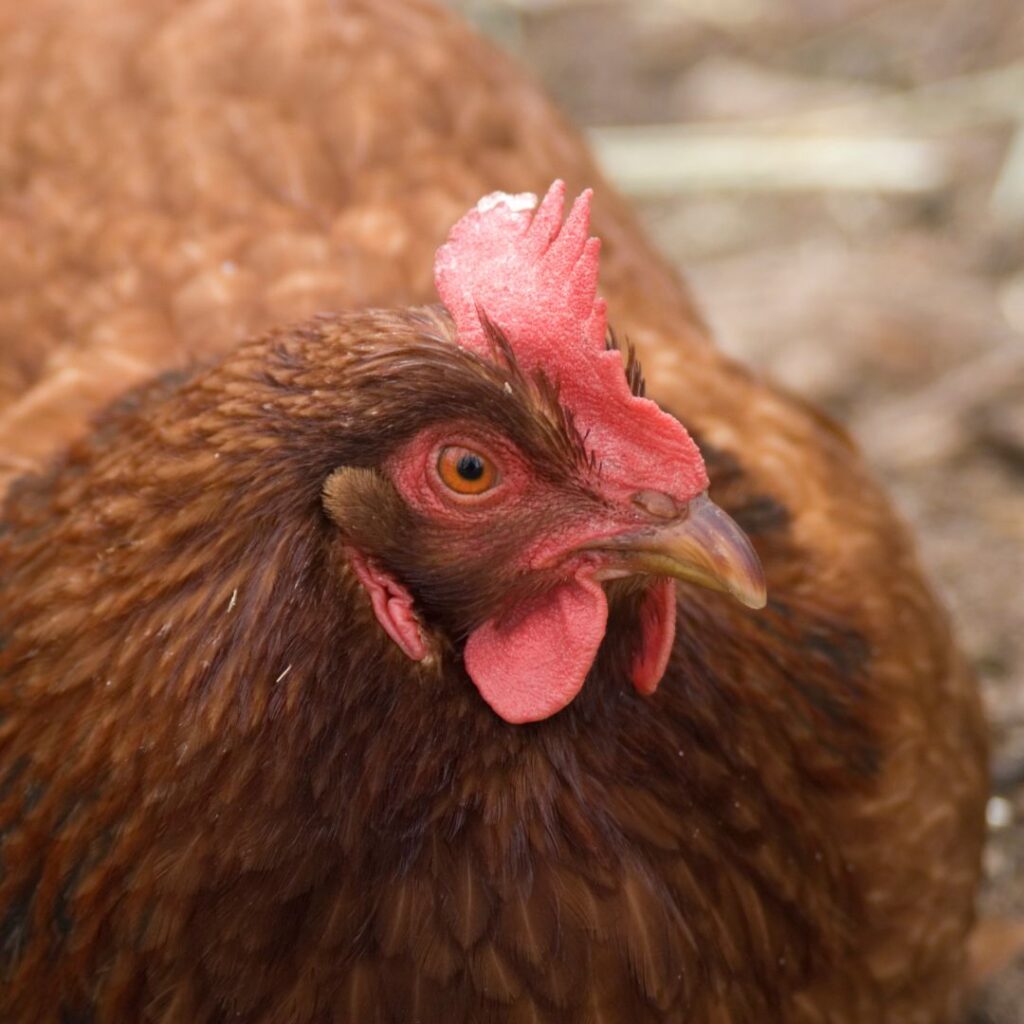
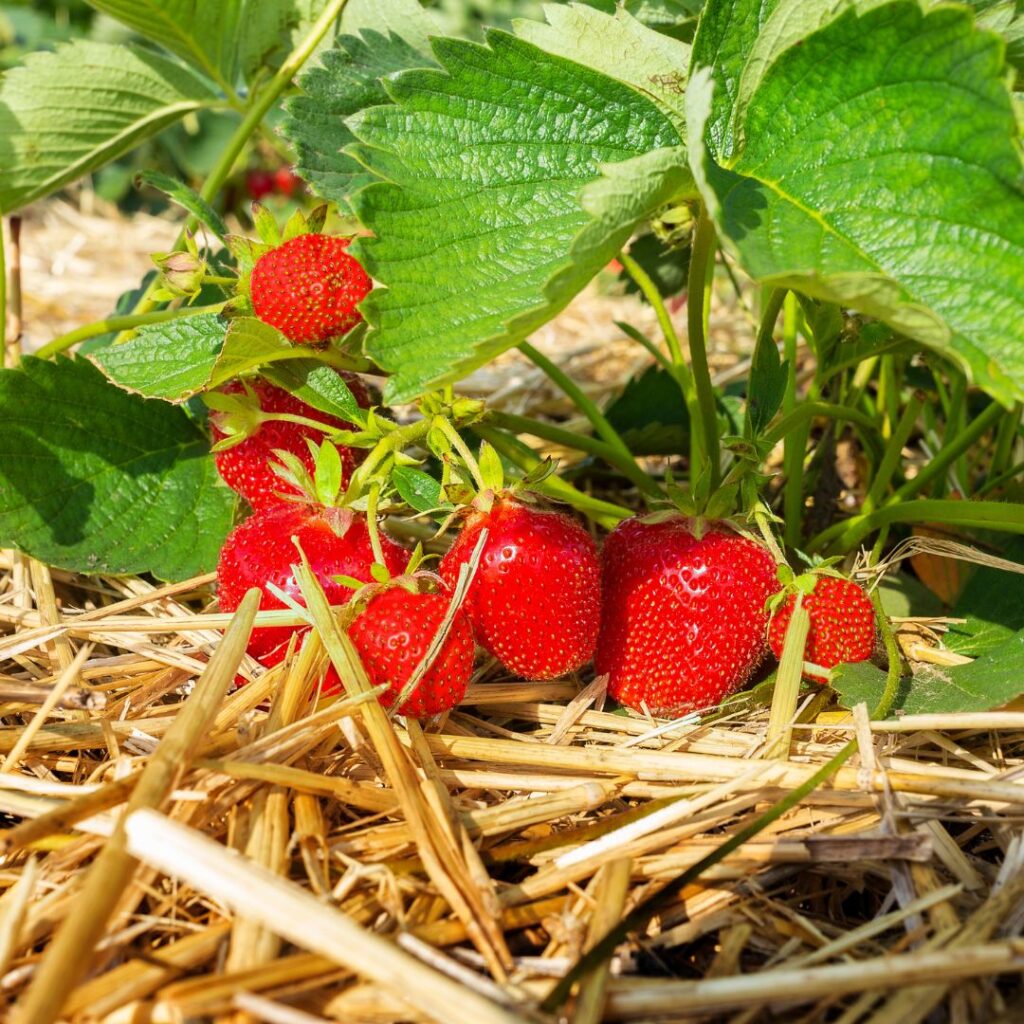
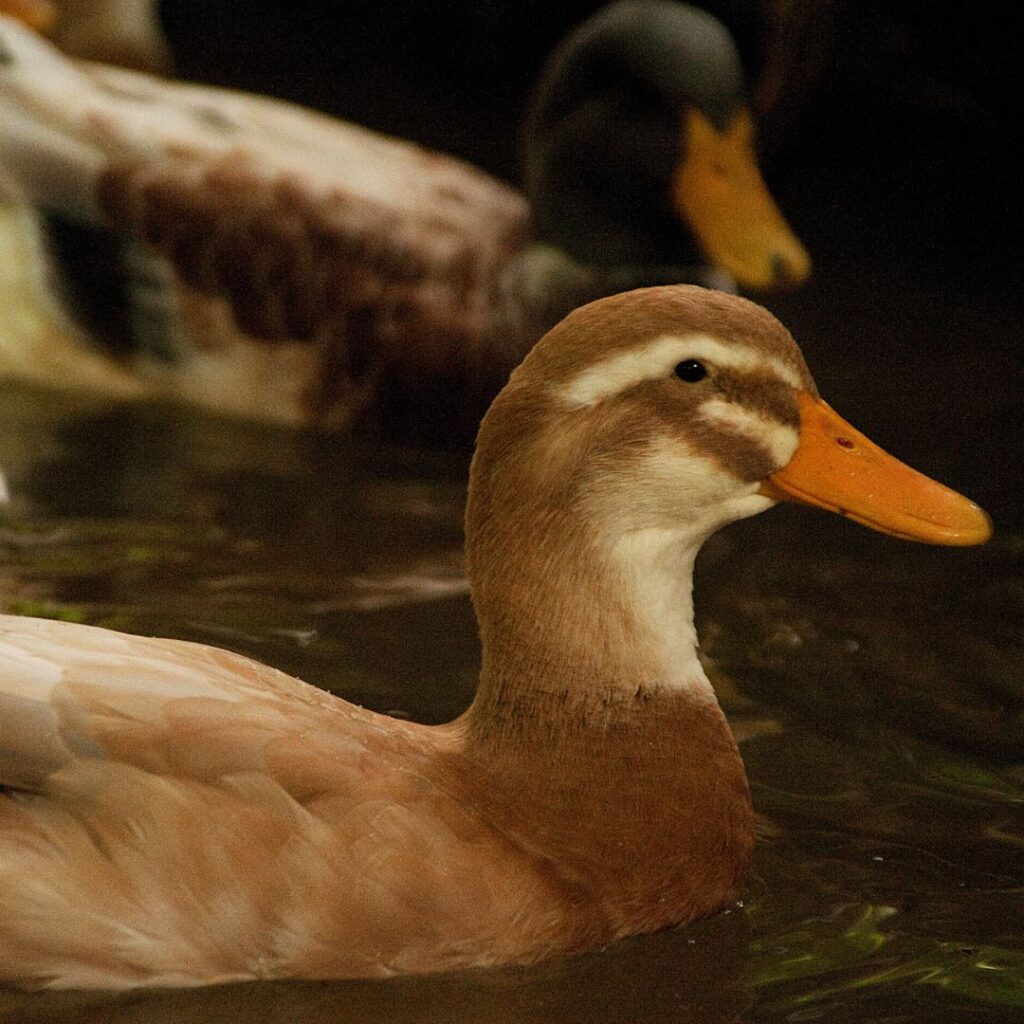
Pingback: 23+ Interesting And Fun Facts About Chickens - Gilmore's
Pingback: 15+ Best Egg Laying Chicken Breeds; Qty, Color, Size Of Eggs
Pingback: Ameraucana Chickens; About These Blue Egg Layers (Not Chicken Americana) - Gilmore's
Pingback: Delaware Chicken Breed; Everything You Need To Know
Pingback: Delaware Chicken Breed; Everything You Need To Know
Pingback: Raising Backyard Chickens; Tips For Beginners - Gilmore's
Pingback: Do Chickens Lay Eggs In Winter Months? How To Encourage Egg Laying Year Round